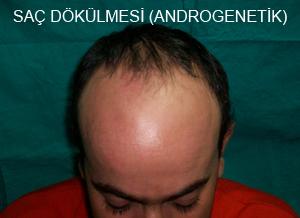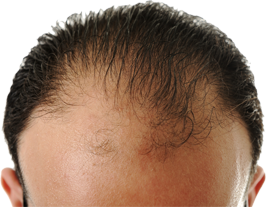Male Pattern (Androgenetic) Hair Loss and Hair Transplantation
Our hair strands have a lifespan. Our hair roots that produce the hair strands usually enter a resting phase after working for a few years. During the resting phase, the connection of the hair with its root loosens and the hair strand falls out through washing, combing or brushing. The hair root which rests for 2-4 months after the loss begins to form a new hair. This cycle of loss and regrowth occurs on different dates for each hair root. Each day, as some of our hair falls out, some other hair begins to regrow. Thus, we lose between 50-100 hair strands on average and grow between 50-100 new hair strands per day. Baldness begins to appear when the balance between regrowth and loss is disrupted. Baldness progresses to the degree that the ratio of the hair loss is greater than that of hair that is regrown.

Male pattern hair loss is the most common type of hair loss in people (including females). It is also called androgenetic hair loss or genetic hair loss. Neither the beginning and the end nor the degree of this type of hair loss can be predicted beforehand. Genetic predisposition is the most important aspect. With genes passed on from mother and father, it has already been determined in the mother's womb whether there will be hair loss in the future or not. Hair loss begins in the twenties in those with significant hair loss in the family. Hair loss occurs most often between the ages of 25 and 35. The loss usually decreases after 45 years of age.
The main hormone responsible for androgenetic hair loss is Dihydrotestosterone (DHT). This hormone is found in both males, and to a lesser extent, in females. The 5-alpha reductase enzyme is found in vast amounts in hair roots that will fall out. This enzyme converts testosterone to DHT. The DHT, which is formed by 5-alpha reductase, adversely affects the hair root. First, there is thinning and weakening of hair and finally hair loss is the consequence. Since hair roots on the nape and both sides of the head do not contain the 5-alpha reductase enzyme, there is no hair loss in these areas. Therefore, these hair roots are used in hair transplantation.
Several treatment methods are being tried in male pattern hair loss. There has been quite a lot of research in this area in the last 20 years. Despite the vast amount of research, there are only two active ingredients with proven efficacy, called Minoxidil and Finasteride, which were approved by the FDA (US Food and Drug Administration).

Minoxidil was earlier used in the treatment of hypertension due to its vasodilator effect. Later its hair growth and baldness prevention effects were discovered and the patent was obtained for it in the 1980s, and it was put on the market. Usually, there is 5% active ingredient in solutions prepared for men and 2% in those prepared for women.Finasteride was first approved in 1992 as a preventive drug for prostate growth.
Finasteride is an antiandrogen and an inhibitor of the 5-alpha reductase enzyme which converts testosterone to dihydrotestosterone (DHT). On December 22, 1997, the FDA approved the use of Finasteride for treating male pattern baldness.
The fact that Finasteride and Minoxidil are not effective in a number of people using them, the need for continuous use, their side effects and the resulting high costs in the long term have limited their success. Aside from hair transplantation, several treatment methods such as a low-level laser, mesotherapy and PRP (Platelet Rich Plasma) are being tried in the treatment of hair loss. However, there has not yet been any effective method, which has been proven and approved.
Nowadays, the safest and most effective method of regaining hair, lost in the treatment of genetic hair loss in men and women, is hair transplantation. Success is limited in hair transplantation, as well. If the patient does not have a sufficient number of healthy roots to be transplanted, success remains limited. In people with a lot of hair loss and fine hair strands, hair that is collected from the nape and the sides of the head may not be enough. The most logical thing to do in this case is to make a distribution of hair roots in order to camouflage baldness. For example, doing a dense transplantation to the front and sparse transplantation towards the back is the most typical form of camouflage. In addition, in the FUE technique, hair can be collected from places such as the chest and the back if there are not sufficient hair roots.

 (WhatsApp)
(WhatsApp)


